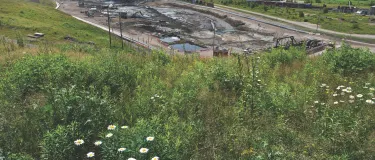As our nation continues to prioritize ongoing rehabilitation and replacement of its transportation and water infrastructure—as well as the remediation of contaminated properties (such as EPA brownfield sites) for beneficial reuse—the leveraging of cementitious materials for ground preparation grows increasingly vital. This is because mixing cementitious materials into soil is one of the most efficient, cost-effective, and widely used methods for stabilizing and solidifying the ground in preparation for construction and redevelopment. Moreover, it is quick, extremely durable, and environmentally responsible.
Soil stabilization and soil remediation applications both require the use of high-performance cements with longer setting and hardening time properties. Unique local soil conditions, specified performance criteria, sustainable development ambitions, and cost-efficiency considerations dictate the need for custom-engineered treatment solutions that are designed and rigorously tested to meet site-specific project goals.
Stronger, More Stable Infrastructure Support
Before any type of construction project can start, a thorough assessment of ground conditions is vital to determine whether a site is stable. Some soils tend to be loose, poorly compacted, or made up of small and unreliable particles. These types of soil compositions are vulnerable to shifting under pressure or eroding during rainy weather. On the other hand, some soils are prone to over-compaction, leading to poor draining. Clay soils can be particularly challenging due to swelling, which can also cause instability.
As roads and highways are repaired or replaced, the subgrade needs to be stabilized by removing moisture, increasing the shear strength, and/or controlling the shrink-swell properties of the soil for the pavement to support and withstand heavy traffic loadings. Although wet, soft, or unstable soil could be excavated, hauled away for disposal, and replaced with quality load-bearing fill, a faster, less expensive, and eco-efficient alternative is to mix cement into the unstable soil to create a strong, firm base.
Soil cement stabilization is typically the method of choice when it comes to assuring the load-bearing capacity and quality of soil in preparation for road construction and civil engineering projects. This requires precise planning based on laboratory analysis to determine the optimal treatment approach. Solutions could involve the application of Portland limestone cement (PLC) or cement kiln dust (CKD) as a standalone treatment, or it may require the use of a custom blend of PLC and CKD or a blend of PLC and a supplementary cementitious material (SCM), such as slag or fly ash. It may also call for a ternary combination of various SCMs blended in proportions required to complete the job successfully.
The applications for soil cement stabilization are virtually limitless. It is widely used for increasing the shear strengths of soils in embankment sections, structural fill zones, and subgrades under any hard-surface pavement, such as building pads, parking lots, and sidewalks. It is also commonly leveraged in water resource projects to support pipelines and sewers, to create pond berms, and to provide slope protection for dams and other types of embankments, such as dikes and levees.
Faster, More Cost-Effective Site Remediation
Most technologies for remediating blighted properties require the costly removal of contaminated soil, some form of treatment, disposal of the treated material in a landfill, and the replenishment of the excavated site with clean backfill. However, a more effective, lower-cost option is to use cement to remediate the soil directly on site. In disposal costs alone, this approach can yield a savings of more than 80 percent.
Approved and used by the EPA for more than 40 years, in-situ cement solidification/stabilization (S/S) is a highly effective remediation method for reclaiming and redeveloping a site without environmental risk. This is accomplished by mixing cement into the soil to solidify and encapsulate the contaminants within the cement matrix, thereby permanently isolating them from the environment.
The stabilization of the soil via S/S converts soluble hazardous metals, such as lead and cadmium, to non-hazardous and insoluble metal hydroxides, thus preventing their leaching into the groundwater or into surface water by precipitation. Cement S/S has also proven to be a highly effective soil remediation option for immobilizing and preventing leaching of organic contaminates, such as polyfluoroalkyl and perfluoroalkyl substances (PFAS), by reducing hydraulic conductivity and aqueous solubility.
Common cementitious materials used in S/S applications include PLC, CKD, fly ash, and slag. Because of the vast types of hazardous materials and site characteristics, most custom-engineered treatment programs rely on a blend of supplementary materials and PLC that is tested for strength, hydraulic conductivity, and other important performance characteristics before a full-scale soil-remediation project gets underway. Blends of PLC and slag, for example, are frequently specified in various proportions when higher ultimate strengths, reduced matrix permeability, and superior resistance to chlorides and sulfates are important performance requirements.
Planning the Optimal Treatment Approach
Holcim has developed a full range of cements and binders that deliver high performance and an environmentally conscious approach to stabilizing and solidifying soils for all types of applications. These products are produced under very strict quality standards, providing an extremely consistent binding agent compared to other materials used for soil treatment.
Customers also have access to our team of technical service engineers who possess unparalleled knowledge about cementitious materials and their use in soil stabilization and remediation applications. These industry and technology experts have tremendous experience in facilitating testing requirements with independent third-party laboratories, analyzing the results, and recommending the most effective site treatment to ensure the project’s success.
Recommended site-specific solutions could involve the use of Type IL cement or CKD as a stand-alone treatment or they could call for a custom-designed binary blend of Type IL and CKD or Type IL and a supplementary cementitious material (SCM), such as slag or fly ash. A solution could even include a ternary mix of various cementitious materials based on project objectives. These products can be blended in the proportions required to complete the job successfully, which is especially important when stabilizing and solidifying contaminated soil.

Committed to your Success
Contact your sales representative or submit an inquiry below to learn more about the ways Holcim can help you with your next project. Our knowledgeable field specialists have a wealth of additional information and best practices to share—helping ensure you achieve outstanding results and long-term customer satisfaction.






